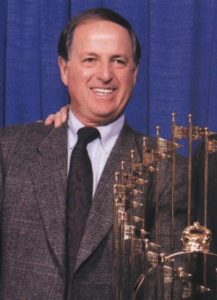By Barry M. Bloom / MLB.com
LAKE BUENA VISTA, Fla. — Pat Gillick, one of the Expansion Era’s top general managers, was elected to the National Baseball Hall of Fame on Monday.
GET YOUR UNSIGNED OR SIGNED PAT GILLICK CBHFM 1997 INDUCTION CARDS HERE.
PAT GILLICK SIGNED CARD $50
PAT GILLICK CARD $9.99
A 16-member committee examining veterans on an Expansion Era ballot for induction voted early on Monday and made the announcement at a news conference that opened the first day of the Winter Meetings. Gillick is only the fourth GM elected to the Hall and the first without New York ties. The others are Ed Barrow and George Weiss of the Yankees and Branch Rickey of the Brooklyn Dodgers.
Read more HERE.
From Hall of Fame President/CEO Tom Valcke:
Gillick is the ultimate professional, a classy, intellectual, book-smart, street-smart, people person with a keen eye for projecting talent. He once heard that Minnesota Twins scout Howie Norsetter and I had worked out a softball player at midnight in the only lit “facility” in Brandon, Manitoba that was available – the parking lot of a 24-hour grocery store, and he couldn’t pepper enough questions at me about the endeavour. He didn’t want to be scooped – he had to be the scooper! He always wanted the edge.
In this vein, I have a Gillick anecdote that few, if any, people know about , to me, perfectly defines the man.
Back in May of 1993, a few dozen power players in the industry flew into Edmonton for what was likely going to be the final evaluation of blue-chip prospect Reginald Quentin Young (a.k.a., Joe Young), prior to the upcoming MLB draft. Young never panned out to be the next Jack Morris that I tagged him to be, but at this point in his baseball evolution, he was a hot property. Tough as nails, body-beautiful, and a solid fastball for his foundation. Because the general managers and scouting directors who were in attendance were on a clock, I was advised ahead of time not to pull my usual stunt of adding another 20 “follows” to the workout that I wanted to showcase while these gurus were going to be in the neighborhood. Begrudgingly, I limited the players to six, including a marginal prospect named Mike Johnson, a rare dual-position guy who I liked a bit more as a pitcher than an outfielder because I wasn’t confident that he would develop the power necessary to bat everyday in the big leagues.
There wasn’t much diplomacy in scouting circles in those days, and while the first five players ran, threw from the outfield, took ground balls and then batting practice, the majority of the big shooters didn’t seem to give a hoot, sitting in their cars, talked on their phones, snacking, chatting with each other, etc. When we gathered the three players on the mound who were slated to pitch, including Young, Johnson, and another whose name I can’t recall, they suddenly clustered together and yanked out their radar guns.
Young was impressive, and while he was liked by everyone, the Blue Jays obviously liked him best because they selected him in the third round. But it was the 17th-round pick by the Blue Jays that this story is really about. Johnson wasn’t overly impressive on the mound that day, appearing to be not much more than yet another skinny six-foot righty who threw 80mph, who were a dime a dozen south of the border. Nobody hardly took note. But the Jays drafted Johnson in the 17th round. Why? Because Gillick, while everyone else was doing anything but scouting, carefully studied every player on the field that day. When he observed Johnson throwing from right field, he saw that Johnson had significantly more velocity from there than he showed when he toed the rubber. Gillick saw that Johnson’s arm strength was there, and that it just needed to be coached out of him on the mound with some mechanical work.
While Joe Young didn’t wind up making it to the show, Mike Johnson did. Gillick, once again, had the edge.
It was just another day in the life of Pat Gillick, but the guy just never missed a trick.













